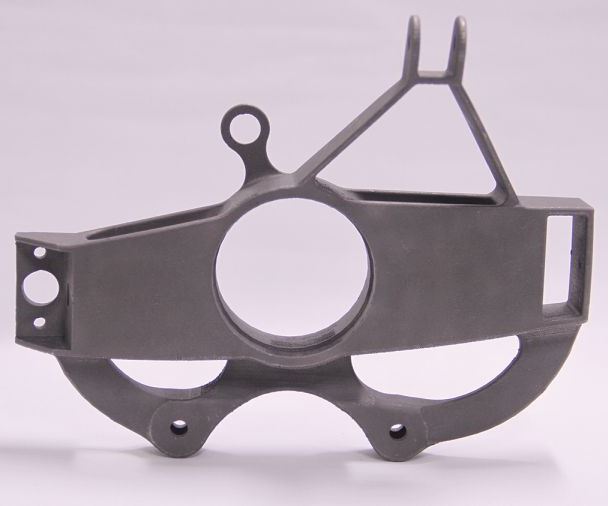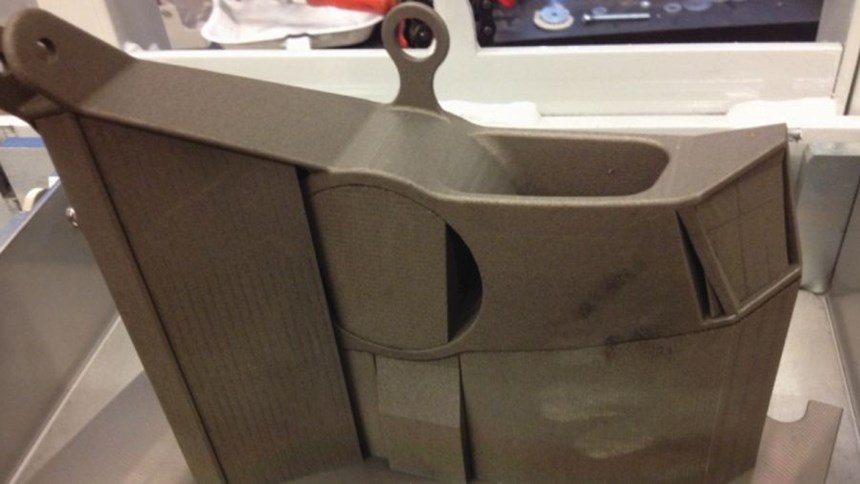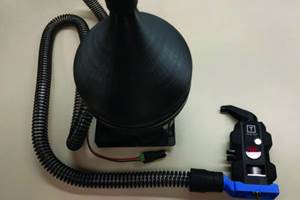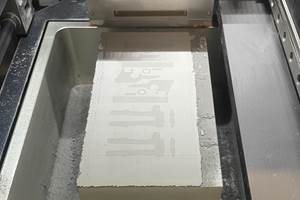Wanted: Flexible Shops and Open-Minded Pros
AM is more complicated than the hype implies. It needs creative people to advance its adoption in this industry.
We have all read the hype: You can 3D-print anything you want. Complexity is “free” when using 3D printing. Additive manufacturing is going to put machining facilities out of business. And so on.
Anyone who has actually seen and worked in additive manufacturing—the layer-by-layer fabrication of end-use parts—quickly realizes that the hype is much different from the reality. The reality is that AM is complicated, and we need agile and flexible machining facilities, along with creative and open-minded machining professionals, to help advance the technology and spur its adoption by the industry. Here’s why:
Consider the part pictured above, a component for the front suspension of a Formula SAE race car designed and built by students at Pennsylvania State University. The part is made of titanium, Ti-6Al-4V to be exact, and was designed and optimized by Vincent Maranan, an undergraduate honors student working with Dr. Todd Palmer, a colleague of mine in the materials science and engineering department. Vincent was able to use readily available design, analysis and optimization codes to lightweight the part, which was then 3D-printed on a laser-based powder-fed fusion system, a common AM process for printing fully dense metal parts.
Additively manufacturing this intricate geometry is relatively easy. The machine does not care whether it is “printing” a solid part or a complex lattice; it just tells the laser where to melt the material (a very fine powder in the case of powder-bed fusion systems) so that it solidifies into a solid part. There are numerous caveats, as one might guess, and the most important one—and perhaps the most relevant to readers interested in AM—is the use of support structures to ensure a successful build.
Because the part is being fabricated layer by layer, the heating and cooling of the metal in each layer can cause the part to distort and the ends to warp up (like a potato chip) if overhanging geometries are not properly supported. As a result, you end up having to print the same part with nearly two dozen support structures and in the orientation illustrated in the second image above. Those new to AM often fail to realize that these support structures are fabricated from the same material as the part (titanium, in this case), as current powder-bed fusion systems are limited to a single material. This means large sections of the part need to be removed before end use. The current solution? Clamp the part in a vice and cut, file, grind and hack away the support structures. Not a very advanced solution for post-processing and finishing a lightweight part made with advanced AM technology.
Support removal provides numerous challenges for post-processing and machining: separation of the part and supports from the build plate; establishing datums and reference points for the part for machining; access and clearances to some areas of the structure; and fixturing and workholding in the necessary orientations, to name just a few. This is where AM gets complicated and the reality is different from the hype. Only agile and flexible machining facilities and practices, along with creative and open-minded machining professionals, will be up to the task.
This article originally appeared in Additive Insights, a monthly column in Modern Machine Shop magazine.
Related Content
NIOSH Publishes 3D Printing Safety Guide for Nonindustrial Settings
NIOSH has published a 3D printing safety guide for small businesses and other additive manufacturing users such as makerspace users, schools, libraries and small businesses.
Read MoreAM 101: What Is Binder Jetting? (Includes Video)
Binder jetting requires no support structures, is accurate and repeatable, and is said to eliminate dimensional distortion problems common in some high-heat 3D technologies. Here is a look at how binder jetting works and its benefits for additive manufacturing.
Read More3D Printing with Plastic Pellets – What You Need to Know
A few 3D printers today are capable of working directly with resin pellets for feedstock. That brings extreme flexibility in material options, but also requires greater knowledge of how to best process any given resin. Here’s how FGF machine maker JuggerBot 3D addresses both the printing technology and the process know-how.
Read MoreUnderstanding PEKK and PEEK for 3D Printing: The Cool Parts Show Bonus
Both materials offer properties desirable for medical implants, among other applications. In this bonus episode, hear more from Oxford Performance Materials and Curiteva about how these companies are applying PEKK and PEEK, respectively.
Read MoreRead Next
3D Printed Polymer EOAT Increases Safety of Cobots
Contract manufacturer Anubis 3D applies polymer 3D printing processes to manufacture cobot tooling that is lightweight, smooth and safer for human interaction.
Read MorePostprocessing Steps and Costs for Metal 3D Printing
When your metal part is done 3D printing, you just pull it out of the machine and start using it, right? Not exactly.
Read MoreProfilometry-Based Indentation Plastometry (PIP) as an Alternative to Standard Tensile Testing
UK-based Plastometrex offers a benchtop testing device utilizing PIP to quickly and easily analyze the yield strength, tensile strength and uniform elongation of samples and even printed parts. The solution is particularly useful for additive manufacturing.
Read More






















